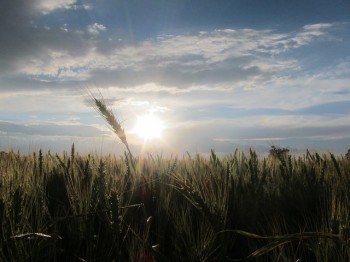Updated Web Wheat Atlas 3.0 prioritizes user experience

EL BATAN, Mexico (CIMMYT) — Got a question about wheat? Whether you are a scientist, a researcher or simply interested in learning more about the vital staple crop that provides 20 percent of the world’s calories, the Wheat Atlas can help.
The online resource developed by the Global Wheat Program (GWP) at the International Maize and Wheat Improvement Center (CIMMYT) provides statistics on wheat production and trade, wheat varieties, production challenges and international wheat nurseries, which evaluate the suitability of wheat to diverse environments.
“Although the primary users are wheat scientists, we know from anecdotal evidence that donors and policymakers are also using it,” said Petr Kosina, who led the development and recent revamp of the interactive website.
The Wheat Atlas was the brainchild of Hans Braun, GWP director, he explained, adding that the project evolved into a collaboration involving Kosina, web master Paul Moncada, senior scientist David Hodson and Tom Payne, head of the Wheat Germplasm Bank, which stores seeds. CIMMYT’s Geographic Information Services team created maps.
Improvements include a redesign of site structure and navigation based on user trends observed in data provided by Google Analytics and a 2013 survey. The website now features daily wheat news on the homepage.
“The work is ongoing,” Kosina said. “We’re in continuous ‘beta mode’, improving the functionality of the site and user experience. For example, we’re developing an online submission form for users to input data on newly released wheat varieties and a wheat scientists’ ‘hall of fame’. Before the end of the year we’ll also improve data visualizations.”
The website provides up-to-date information on new wheat varieties being released worldwide, as well as data from the U.N. Food and Agriculture Organization, the U.S. Department of Agriculture, the World Bank and the U.N. Development Programme.
Since the official launch of the Wheat Atlas in 2009, web traffic has increased to an average of 2,200 unique visitors a month, said Kosina, who works closely with webmaster Moncada.
“We’re very happy with recent access statistics, which have improved since the Search Engine Optimization we did earlier this year, but we need secure funding for bigger plans and development,” he said. “We need a new source of funding.”
The Wheat Atlas was supported until 2013 by the Durable Rust Resistance in Wheat project, which aims to reduce the devastating impact of stem rust disease on wheat, led by Cornell University.
The CIMMYT library has a large historic database of scientific publications with descriptions of new wheat varieties compiled over a 15-year time span, Kosina said.
“My dream is to consolidate this database with the Wheat Atlas and GRIS, the world’s largest database of wheat germplasm, with more than 160,000 accessions, and make it available online in the Wheat Atlas – this would be absolutely unique and smashing,” he added.
Every two years, the site managers gather information to provide a snapshot of the most important wheat varieties grown by farmers in developing countries, including acreage estimates. Mina Lantican in CIMMYT’s socio-economics program is conducting the 2014 review as part of an impact assessment study.